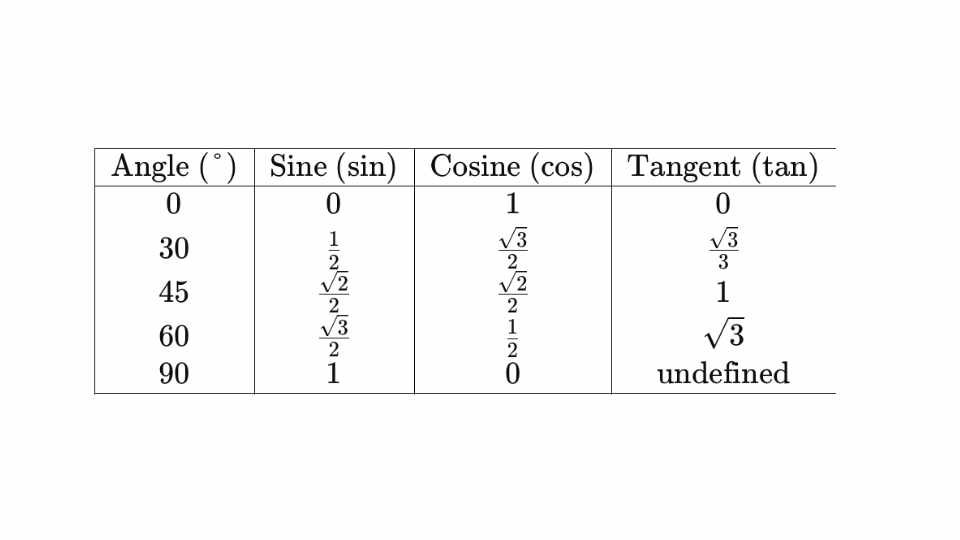Trigonometry Table: A Complete Guide: Trigonometry, the study of the relationships between the angles and sides of triangles, is a fundamental branch of mathematics with wide-ranging applications in various fields like physics, engineering, architecture, and more. One of the essential tools in trigonometry is the trigonometric table, which provides values of trigonometric functions for different angles. In this guide, we’ll delve into the details of the trigonometry table, its importance, and how to use it effectively.

What is a Trigonometry Table?
A trigonometry table is a table of values for trigonometric functions such as sine, cosine, tangent, cosecant, secant, and cotangent for different angles. These values are typically provided for standard angles, often in degrees or radians. While calculators and computers can readily calculate these values, understanding the trigonometry table is crucial for developing a deeper comprehension of trigonometric relationships and for situations where electronic devices aren’t available.
Importance of Trigonometry Table
- Quick Reference: Trigonometry tables provide a quick reference for trigonometric values, enabling rapid calculations without the need for electronic devices.
- Understanding Trigonometric Relationships: By examining the values in the table, one can discern patterns and relationships between angles and trigonometric functions.
- Building Mathematical Skills: Using a trigonometry table encourages students to practice mental math and develop a deeper understanding of trigonometric concepts.
- Historical Significance: Trigonometry tables have a rich history and have been used for centuries by mathematicians, scientists, and engineers to solve complex problems.
Components of a Trigonometry Table
A typical trigonometry table contains values for sine, cosine, tangent, cosecant, secant, and cotangent functions for various angles. These values are usually given for angles in degrees or radians.
Here’s a brief overview of each function:
- Sine (sin): The ratio of the length of the side opposite an acute angle to the length of the hypotenuse in a right triangle.
- Cosine (cos): The ratio of the length of the adjacent side to the length of the hypotenuse in a right triangle.
- Tangent (tan): The ratio of the length of the side opposite an acute angle to the length of the adjacent side in a right triangle.
- Cosecant (csc): The reciprocal of the sine function.
- Secant (sec): The reciprocal of the cosine function.
- Cotangent (cot): The reciprocal of the tangent function.
How to Use a Trigonometry Table
Using a trigonometry table involves looking up the values of the trigonometric functions for the given angle. Here are the basic steps:
- Locate the Angle: Find the row corresponding to the angle you’re interested in.
- Read the Values: Once you’ve found the row for the angle, read off the values of the trigonometric functions from that row.
Example Trigonometry Table
Below is a sample trigonometry table showing values for sine, cosine, and tangent functions for angles from 0° to 90°:
Conclusion
Trigonometry tables are valuable tools for understanding and calculating trigonometric functions. By familiarizing yourself with the table and its components, you can enhance your mathematical skills and develop a deeper understanding of trigonometry. Whether you’re a student, a professional, or an enthusiast, mastering the trigonometry table is essential for solving various mathematical problems and understanding the world around us.
Introduction to Trigonometry
Trigonometry is a branch of mathematics that deals with the relationships between angles and sides of triangles. It is a fundamental concept in both pure mathematics and its real-world applications. In this chapter, we will explore the basic principles of trigonometry, including angles, right triangles, and the six trigonometric functions.
To begin our journey into trigonometry, let’s first understand what an angle is. An angle is formed when two rays share a common endpoint called the vertex. The rays are known as the arms or sides of the angle. Angles are measured in degrees (°) or radians (rad), with a complete revolution being 360° or 2π radians.
Next, we delve into one of the key elements of trigonometry: right triangles. A right triangle is a triangle that has one angle measuring exactly 90°. This specific type of triangle allows us to define the six trigonometric functions: sine (sin), cosine (cos), tangent (tan), cosecant (csc), secant (sec), and cotangent (cot). These functions relate angles to ratios of side lengths within right triangles.
Let’s take a closer look at each function:
– Sine (sin): The sine function relates the length of the side opposite an angle to the hypotenuse in a right triangle.
– Cosine (cos): The cosine function relates the length of the side adjacent to an angle to the hypotenuse.
– Tangent (tan): The tangent function relates the length of the side opposite an angle to its adjacent side.
– Cosecant (csc): The cosecant function is defined as 1 divided by sine.
– Secant (sec): The secant function is defined as 1 divided by cosine.
– Cotangent (cot): The cotangent function is defined as 1 divided by tangent.
These functions can be represented as ratios or values on a trigonometry table. A trigonometry table provides the values of trigonometric functions for specific angles, typically ranging from 0° to 90°. By consulting this table, we can easily find the sine, cosine, tangent, cosecant, secant, and cotangent values for any given angle.
Understanding how to use a trigonometry table is essential in solving various mathematical problems and real-world applications. For example, in navigation or engineering, trigonometry helps determine distances between points or heights of structures using angle measurements and known side lengths.
Now that we have introduced the basic concepts of angles, right triangles, and the six trigonometric functions along with their corresponding ratios on a trigonometry table; we are ready to embark on a deeper exploration of these functions in Chapter 2 – “Understanding Trigonometric Functions.” In this next chapter, we will examine each function in detail and learn how they can be applied to solve problems involving angles and sides of triangles.
By mastering the fundamentals covered in this chapter and throughout this book titled “Trigonometry Table,” you will develop a strong foundation in trigonometry that will enable you to tackle more advanced topics such as applying trigonometry in geometry (Chapter 3), understanding trigonometric identities (Chapter 4), solving trigonometric equations (Chapter 5), and exploring real-life applications (Chapter 6). This comprehensive understanding of trigonometry will empower you to pursue further studies in mathematics or related fields with confidence.
In the next chapter – “Understanding Trigonometric Functions” – we will delve deeper into each function’s properties and explore their applications through practical examples. So let’s continue our journey into the world of Trigonometry!
In this chapter, we will delve deeper into the six trigonometric functions: sine, cosine, tangent, cosecant, secant, and cotangent. Each function plays a crucial role in trigonometry and has unique properties that make it useful in solving various mathematical problems.
Let’s begin by exploring the sine function. The sine of an angle is defined as the ratio of the length of the side opposite to that angle to the hypotenuse in a right triangle. This function is denoted as sin(theta), where theta represents the measure of an angle. The range of values for sine extends from -1 to 1.
The cosine function complements the sine function by measuring the ratio of the length of the adjacent side to that angle to the hypotenuse. Similar to sine, cosine is also denoted as cos(theta) and has a range from -1 to 1.
Next, we have tangent which is defined as the ratio of sin(theta) divided by cos(theta). In other words, tangent represents the slope or inclination of a line passing through a point on a unit circle with respect to its center at (0,0). We use tan(theta) notation for tangent.
Cosecant (csc), secant (sec), and cotangent (cot) are reciprocal functions derived from their respective counterparts. Cosecant is equal to 1/sin(theta), secant equals 1/cos(theta), and cotangent equals 1/tan(theta).
To better understand these functions, let’s consider an example:
Suppose we have a right triangle with one acute angle measuring 45 degrees and one side measuring √2 units. To find out how long each side would be using trigonometric functions:
Using sin(45°) = opposite/hypotenuse,
sin(45°) = x/√2,
x = √2 * sin(45°) = √2 * 1/√2 = 1.
Using cos(45°) = adjacent/hypotenuse,
cos(45°) = y/√2,
y = √2 * cos(45°) = √2 * 1/√2 = 1.
Using tan(45°) = opposite/adjacent,
tan(45°) = x/y,
tan(45°) = 1/1 = 1.
Similarly, we can calculate the values of cosecant, secant, and cotangent for this angle using their respective definitions and reciprocal properties.
Now that we understand the definitions and properties of these trigonometric functions, let’s explore how they can be used to solve problems involving angles and sides of triangles. Trigonometric functions can help us find missing side lengths or angles in different types of triangles.
Additionally, these functions are valuable in solving more complex problems involving geometric figures. For instance, the Pythagorean theorem plays a pivotal role in trigonometry as it connects the lengths of the sides in a right triangle. By combining trigonometric ratios with the Pythagorean theorem, we can solve various geometry problems efficiently.
Special right triangles such as the 30-60-90 and 45-45-90 triangles also play important roles in trigonometry. These triangles have specific ratios between their side lengths that make calculations simpler. By recognizing these special cases and utilizing trigonometric functions appropriately, we can tackle geometry problems more effectively.
In summary, this chapter has provided an in-depth understanding of the six trigonometric functions: sine, cosine, tangent, cosecant, secant, and cotangent. We explored their definitions and properties while emphasizing their significance in solving mathematical problems involving angles and sides of triangles. Furthermore, we discussed how these functions can be combined with the Pythagorean theorem and special right triangles to enhance our problem-solving capabilities in geometry. Understanding and mastering these trigonometric functions will lay a solid foundation for further exploration in the field of trigonometry.
Continue reading further chapters to uncover more advanced topics such as trigonometric identities, solving equations involving trigonometric functions, and real-life applications of trigonometry in various fields. The journey towards becoming a master of trigonometry has just begun
In this chapter of “Trigonometry Table,” we will explore the practical application of trigonometry in the field of geometry. Trigonometric ratios play a crucial role in solving problems related to angles and sides of different types of triangles. By using these ratios, we can determine unknown side lengths or angles within a triangle.
To begin our exploration, let’s first understand the basic trigonometric ratios that are used extensively in geometry. These ratios are sine, cosine, and tangent, often referred to as sin, cos, and tan respectively. Each ratio is defined based on the relationship between the sides of a right triangle.
In a right triangle ABC, where angle C is the right angle:
– The sine (sin) of angle A is equal to the ratio of the length of side opposite angle A (side BC) to the length of hypotenuse AB.
– The cosine (cos) of angle A is equal to the ratio of the length of side adjacent to angle A (side AC) to the length of hypotenuse AB.
– The tangent (tan) of angle A is equal to the ratio of sin(A)/cos(A).
Using these definitions, we can now apply trigonometry in various geometric scenarios.
One common application involves finding missing side lengths or angles within a triangle. For example, given an acute triangle with known side lengths but unknown angles, we can use inverse trigonometric functions such as arcsin, arccosine, or arctangent along with our knowledge about trigonometric ratios to determine these angles accurately.
Another important tool in applying trigonometry within geometry is utilizing special right triangles: 30-60-90 and 45-45-90 triangles. These triangles have fixed relationships between their side lengths which make calculations simpler.
The 30-60-90 triangle has one angle measuring 30 degrees, another measuring 60 degrees, and the remaining angle measuring 90 degrees. The ratio of the lengths of the sides in this triangle is always x : x√3 : 2x, where x represents a constant value.
The 45-45-90 triangle has two angles measuring 45 degrees each and the remaining angle measuring 90 degrees. The ratio of the lengths of the sides in this triangle is always x : x : x√2.
By understanding these special triangles and their ratios, we can easily find missing side lengths or angles within them by applying basic trigonometric principles.
Additionally, the Pythagorean theorem is an essential tool when dealing with right triangles. This theorem states that in a right triangle, the square of the length of hypotenuse (the side opposite to the right angle) is equal to the sum of squares of the lengths of other two sides. Using this theorem in combination with trigonometric ratios allows us to solve complex geometric problems involving right triangles efficiently.
Throughout this chapter, we will provide numerous examples illustrating how trigonometry can be applied in geometry. These examples will cover scenarios such as finding unknown side lengths using trigonometric ratios or solving for angles using inverse trigonometric functions.
Furthermore, we will discuss how to identify if a problem requires applying trigonometry by carefully analyzing given information and recognizing geometric patterns within a problem statement. This skill will be crucial for readers as they encounter different geometry problems that require utilizing trigonometry concepts effectively.
By mastering these applications of trigonometry in geometry, readers will gain a solid foundation for further exploration into more advanced math topics and real-life applications discussed later in this book.
In summary, Chapter 3 focuses on applying trigonometry within geometry by utilizing fundamental concepts such as trigonometric ratios, special right triangles (30-60-90 and 45-45-90), and Pythagorean theorem. The chapter will provide detailed explanations, examples, and problem-solving techniques to enhance readers’ understanding of trigonometry’s practical significance in solving geometric problems effectively.
Trigonometric identities are fundamental equations that relate different trigonometric functions. In this chapter, we will delve into the world of trigonometric identities and explore their various forms and applications. Understanding these identities is crucial for simplifying complex expressions involving trigonometric functions and solving equations.
To begin, let’s start with the concept of reciprocal identities. Reciprocal identities involve the reciprocals of sine, cosine, tangent, cosecant, secant, and cotangent functions. These identities are derived from the definitions of these functions in relation to a right triangle.
For any angle θ in a right triangle:
– The sine of θ (sin θ) is equal to the length of the side opposite θ divided by the hypotenuse.
– The cosine of θ (cos θ) is equal to the length of the adjacent side divided by the hypotenuse.
– The tangent of θ (tan θ) is equal to the length of the opposite side divided by the adjacent side.
Using these definitions, we can derive reciprocal identities such as:
– csc(θ) = 1/sin(θ)
– sec(θ) = 1/cos(θ)
– cot(θ) = 1/tan(θ)
Reciprocal identities allow us to express one trigonometric function in terms of another and vice versa. This flexibility proves invaluable when simplifying complicated expressions or solving equations involving trigonometric functions.
Another set of important trigonometric identities are quotient identities. These involve dividing one trigonometric function by another. One example is:
– tan(θ) = sin(θ)/cos(θ)
Similarly, we have cosecant squared equals one plus cotangent squared:
– csc^2(θ) = 1 + cot^2(θ)
Quotient identities help us relate different trigonometric functions and provide alternative ways of expressing them.
Pythagorean identities are among the most fundamental and widely used in trigonometry. One example is:
– sin^2(θ) + cos^2(θ) = 1
This identity relates the squares of sine and cosine functions to a constant value, which is always equal to one. It forms the basis for many other trigonometric identities and plays a crucial role in simplifying expressions.
Sum and difference formulas are another set of identities that allow us to express the sine, cosine, or tangent of the sum or difference of two angles in terms of their individual sines, cosines, or tangents. For example:
– sin(A + B) = sin(A)cos(B) + cos(A)sin(B)
These formulas prove invaluable when dealing with complex expressions involving multiple angles.
Double angle formulas expand on the sum and difference formulas by allowing us to express trigonometric functions of an angle twice as large in terms of its original value. One example is:
– sin(2θ) = 2sin(θ)cos(θ)
Double angle formulas find applications in various mathematical problems and real-world scenarios.
Half-angle formulas provide a way to express trigonometric functions at half an angle’s measure using known values at full angles. For instance:
– sin(θ/2) = ±√[(1 – cos(θ))/2]
These formulas are useful when we need to work with smaller angles but only have information about larger ones.
Throughout this chapter, we will explore proofs for these identities and demonstrate how they can be applied effectively. Understanding these identities will not only simplify calculations but also enhance our problem-solving abilities in both mathematics and real-life applications.
As we progress through this chapter, it is essential to keep practicing these identities until they become second nature. Learning how different trigonometric functions relate to one another will significantly enhance your grasp of trigonometry as a whole.
In the next section, we will dive deeper into the applications of trigonometric identities and how they can be used to simplify complex expressions and solve trigonometric equations. Let’s continue on our journey towards mastering trigonometry
Introduction:
In this chapter, we will delve into the techniques and strategies for solving equations involving trigonometric functions. Equations in trigonometry can be challenging, but with the right tools and understanding, we can find solutions that help us solve real-world problems. By the end of this chapter, you will have gained the skills to confidently tackle trigonometric equations and apply them in various contexts.
5.1 Solving Linear Equations:
We begin by exploring how to solve linear equations involving trigonometric functions. A linear equation is one where the highest power of the variable is 1. To solve such an equation, we use inverse operations or algebraic manipulations to isolate the variable on one side of the equation.
For example, let’s consider the equation sin(x) = 0.5. To find its solutions, we need to determine which angles have a sine value of 0.5. By referring to our knowledge of unit circle or using a trigonometry table, we find that sin(x) = 0.5 when x = π/6 or x = 5π/6.
However, it’s important to keep in mind that trigonometric functions are periodic with a period of 2π (or 360 degrees). Therefore, when solving linear equations involving trigonometric functions, it’s essential to consider all possible solutions within a given interval.
5.2 Solving Multiple Variable Equations:
In some cases, we may encounter equations with multiple variables involving different trigonometric functions. These types of equations require algebraic manipulations and problem-solving skills.
Consider an equation like sin(x) + cos(y) = √2/2. To solve this equation for both x and y simultaneously requires careful analysis and manipulation of both sides of the equation.
One approach is to use Pythagorean identities like sin^2(x) + cos^2(x) = 1 to rewrite the equation in terms of a single variable. By substituting sin^2(x) with 1 – cos^2(x), we can transform the equation into a quadratic equation involving only one variable.
Once we have solved for one variable, we can substitute that solution back into the original equation to find the possible values for other variables.
5.3 Dealing with Extraneous Solutions:
While solving trigonometric equations, it’s essential to be aware of extraneous solutions. These are solutions that satisfy the algebraic manipulation but do not satisfy the original equation. They often arise when squaring both sides or canceling out common factors during the solving process.
For instance, let’s consider an equation like sin(x) = -1/√2. This equation has no real solutions since sine values range between -1 and 1 inclusively. However, if we square both sides and solve for x, we may obtain a solution x = π/4. But upon substituting this value back into the original equation, we find that it does not satisfy sin(x) = -1/√2.
To avoid extraneous solutions, it’s crucial to check each obtained solution by substituting it back into the original equation and verifying its validity.
Conclusion:
In this chapter on solving trigonometric equations, we explored techniques for solving linear equations with a single variable and multiple-variable equations involving different trigonometric functions. We also discussed how to deal with extraneous solutions that may arise during the solving process.
Mastering these skills will enable you to confidently solve complex trigonometric equations and apply them in various real-life scenarios such as physics problems involving oscillations or engineering problems requiring angle calculations.
As you continue your journey through “Trigonometry Table,” remember that practice is key to honing your problem-solving abilities in trigonometry. The next chapter will focus on the practical applications of trigonometry in real-life situations, further solidifying your understanding and appreciation for this powerful mathematical tool
Introduction:
In the previous chapters of “Trigonometry Table,” we have explored the fundamental concepts and applications of trigonometry. We have learned about angles, right triangles, trigonometric functions, identities, and equations. Now, it’s time to delve into the real-life applications of trigonometry that bring this mathematical discipline to life.
Section 1: Navigation
Trigonometry plays a crucial role in navigation, allowing us to determine our position and plot accurate courses on land, sea, or air. By using trigonometric functions such as sine and cosine along with instruments like compasses or GPS systems, sailors can calculate their latitude and longitude coordinates accurately. Furthermore, pilots rely on trigonometry to navigate through the skies by calculating distances between points using angles provided by instruments like altimeters and gyroscopes.
One practical example of navigation using trigonometry is finding the distance between two landmarks without physically measuring them. By utilizing triangulation methods that involve measuring angles from different positions relative to the landmarks, we can use trigonometric ratios to determine distances accurately. This technique is widely used in cartography for creating accurate maps.
Section 2: Engineering
Trigonometry is an indispensable tool for engineers working in various fields such as civil engineering, mechanical engineering, electrical engineering, and more. In civil engineering projects like bridge construction or building skyscrapers with complex geometries, understanding angles and triangles becomes essential for designing structures that are stable and safe.
Mechanical engineers utilize trigonometry when designing machines with moving parts or analyzing force vectors acting on those parts. By applying principles of statics combined with knowledge of angles and forces obtained through trigonometric calculations, they can ensure optimal performance while minimizing risks.
In electrical engineering applications such as circuit design or signal processing, understanding waveforms involves working with sine waves extensively. Trigonometric functions allow engineers to manipulate and analyze these waveforms, enabling the development of efficient electronic systems.
Section 3: Physics and Astronomy
Trigonometry plays a fundamental role in understanding and solving problems in physics and astronomy. In physics, concepts like projectile motion or oscillations can be described using trigonometric functions. For example, the motion of a pendulum or the path followed by a launched projectile can be analyzed using trigonometric ratios.
In astronomy, trigonometry helps us measure distances between celestial objects and calculate their sizes or orbits. By observing the angle subtended at different locations on Earth when viewing an object in space, astronomers can determine its distance using trigonometric principles. This technique forms the basis for methods like parallax measurements used to estimate stellar distances.
Section 4: Other Applications
Beyond navigation, engineering, physics, and astronomy, trigonometry finds applications in various other fields as well. In architecture and construction, understanding angles is crucial for designing structures with aesthetic appeal while maintaining stability.
Trigonometry also finds relevance in computer graphics and animation. By manipulating angles and coordinates through trigonometric calculations, realistic animations are created that mimic natural movements or simulate complex physical phenomena.
Furthermore, sound engineers utilize trigonometry to design speaker arrays that provide optimal sound coverage by considering factors such as angular dispersion patterns.
Conclusion:
In this chapter of “Trigonometry Table,” we have explored several real-life applications where trigonometry plays a vital role. From navigation to engineering disciplines such as civil engineering or electrical engineering to physics and astronomy-related calculations—trigonometry proves its worth across different domains.
Understanding how angles relate to triangles allows us to solve complex problems accurately while making informed decisions in practical scenarios. By mastering the concepts covered throughout this book, readers will gain valuable skills applicable not only within mathematics but also across numerous fields where precise measurements or calculations are required.
As we conclude this chapter on real-life applications of trigonometry, let’s reflect on the importance of this mathematical discipline in solving problems and exploring the world around us. Trigonometry truly is an essential tool that empowers us to understand and manipulate our physical reality
In this concluding chapter of “Trigonometry Table,” we will summarize the key concepts and skills that have been covered throughout the book. Our journey through trigonometry has provided us with a comprehensive understanding of this branch of mathematics and its real-life applications. As we wrap up our exploration, let us reflect on the knowledge gained and discuss potential avenues for further growth.
Throughout this book, we have delved into various aspects of trigonometry, starting from an introduction to its basic concepts in Chapter 1. We learned about angles, right triangles, and the six fundamental trigonometric functions – sine, cosine, tangent, cosecant, secant, and cotangent. These functions play a crucial role in solving problems involving angles and sides of triangles.
Chapter 2 deepened our understanding of these trigonometric functions by exploring their definitions and properties. We saw how these functions can be used to find missing angles or side lengths in different types of triangles. By mastering these functions, we have acquired a powerful set of tools for solving geometric problems.
In Chapter 3, we applied trigonometry in geometry by using trigonometric ratios to determine unknown sides or angles in various triangle configurations. We discussed essential tools like the Pythagorean theorem and special right triangles (30-60-90 and 45-45-90) that enable us to approach geometric challenges with confidence.
Moving on to Chapter 4, we explored a range of trigonometric identities – equations that relate different trigonometric functions. These identities include reciprocal identities, quotient identities, Pythagorean identities, sum/difference formulas, double angle formulas, and half-angle formulas. Understanding these identities allows us to simplify complex expressions involving trigonometric functions effectively.
Chapter 5 equipped us with techniques for solving equations involving trigonometric functions. We tackled linear equations with single or multiple variables, employing inverse operations and algebraic manipulations. Moreover, we discussed strategies for identifying and dealing with extraneous solutions that may arise during the solving process.
Finally, in Chapter 6, we discovered the real-life applications of trigonometry. We explored how this branch of mathematics is utilized in navigation, engineering, physics, astronomy, and other disciplines. Through engaging examples and case studies, we witnessed firsthand the practical relevance and significance of trigonometry in solving real-world problems.
As we conclude our journey through “Trigonometry Table,” it is crucial to recognize the progress made in mastering this subject. Trigonometry is not merely a collection of formulas; it is a powerful tool that enables us to understand and analyze the world around us. By studying this book diligently and practicing its principles through exercises and real-world applications, you have developed a solid foundation in trigonometry.
To continue your mathematical journey beyond this book’s scope, there are countless opportunities for further exploration. Advanced topics in trigonometry like inverse trigonometric functions, complex numbers in trigonometric form (Euler’s formula), or spherical trigonometry can deepen your understanding even more.
Moreover, you may consider pursuing further studies in mathematics or related fields such as engineering or physics. These disciplines heavily rely on strong mathematical skills like those acquired through mastering trigonometry. By expanding your knowledge base and applying your skills across different contexts, you can make substantial contributions to these fields.
In closing “Trigonometry Table,” I urge you not to view this concluding chapter as an endpoint but rather as a stepping stone towards lifelong learning. The world of mathematics offers endless opportunities for exploration and discovery. Embrace the challenges that lie ahead with confidence knowing that you have developed a solid understanding of trigonometry – an essential pillar supporting higher-level mathematical concepts.
May your journey continue with enthusiasm as you explore new territories within mathematics and beyond! Remember to approach each new challenge with the same dedication and determination that brought you to this point. Congratulations on mastering trigonometry, and may your future endeavors be equally rewarding
1. What is a trigonometry table?
A trigonometry table is a reference tool that provides values of trigonometric functions for different angles. These functions include sine, cosine, tangent, cosecant, secant, and cotangent. It allows for quick calculations of trigonometric values without the need for electronic devices.
2. How are trigonometry tables organized?
Trigonometry tables typically organize values by angles, usually in degrees or radians. The values of trigonometric functions such as sine, cosine, and tangent are listed corresponding to each angle. This organization makes it easy to find the desired trigonometric value for a given angle.
3. What are the standard angles in a trigonometry table?
Standard angles in a trigonometry table often include 0°, 30°, 45°, 60°, and 90°. These angles are commonly used in trigonometric calculations and provide a basis for understanding trigonometric relationships.
4. How do you read a trigonometry table?
To read a trigonometry table, first, locate the row corresponding to the angle of interest. Then, find the column for the desired trigonometric function. The value in the intersection of the row and column represents the value of that trigonometric function for the given angle.
5. Why is it important to learn how to use a trigonometry table?
Understanding how to use a trigonometry table is important because it allows for quick and accurate calculations of trigonometric values without the need for electronic devices. It also helps in developing a deeper understanding of trigonometric relationships and patterns, which are essential in various fields such as physics, engineering, and architecture.
6. What is the sine function in trigonometry?
The sine function in trigonometry, denoted as sin, represents the ratio of the length of the side opposite an acute angle to the length of the hypotenuse in a right triangle. It oscillates between -1 and 1 as the angle varies from 0 to 360 degrees (or 0 to 2π radians). In trigonometry tables, the sine values are listed corresponding to different angles.
7. What is the cosine function in trigonometry?
The cosine function in trigonometry, denoted as cos, represents the ratio of the length of the adjacent side to the length of the hypotenuse in a right triangle. Like the sine function, cosine oscillates between -1 and 1 as the angle varies. In trigonometry tables, cosine values are provided for different angles.
8. What is the tangent function in trigonometry?
The tangent function in trigonometry, denoted as tan, represents the ratio of the length of the side opposite an acute angle to the length of the adjacent side in a right triangle. Unlike sine and cosine, tangent can take on any real value. Trigonometry tables list tangent values for various angles.
9. What are the reciprocal trigonometric functions?
The reciprocal trigonometric functions are cosecant (csc), secant (sec), and cotangent (cot). They are the reciprocals of sine, cosine, and tangent, respectively. In other words, cosecant is the reciprocal of sine, secant is the reciprocal of cosine, and cotangent is the reciprocal of tangent.
10. How do you find the cosecant, secant, and cotangent values from a trigonometry table?
To find the values of cosecant, secant, and cotangent from a trigonometry table, first, locate the sine, cosine, and tangent values for the given angle. Then, take the reciprocal of each of these values to find the corresponding cosecant, secant, and cotangent values.
11. Why are there undefined values in a trigonometry table?
Undefined values appear in trigonometry tables for angles where the cosine or sine is zero, resulting in division by zero for certain trigonometric functions like tangent, cosecant, and secant. For example, at 90°, the tangent, cosecant, and secant are undefined because cosine is zero.
12. How do you use a trigonometry table to solve trigonometric equations?
Trigonometry tables can be used to find the values of trigonometric functions for given angles, which are then substituted into trigonometric equations. By matching these values with the known values in the table, you can solve equations involving trigonometric functions.
13. Can trigonometry tables be used for angles beyond the standard ones?
Yes, trigonometry tables can be used for angles beyond the standard ones by employing interpolation techniques. Interpolation involves estimating values for angles that are not explicitly listed in the table based on the known values for nearby angles.
14. What are the limitations of using trigonometry tables?
Trigonometry tables have limitations when dealing with angles not listed in the table, and interpolation may introduce errors. Moreover, trigonometry tables are not as convenient as electronic devices for quick calculations, especially for angles beyond the standard ones.
15. How do you convert between degrees and radians using a trigonometry table?
To convert between degrees and radians using a trigonometry table, you can use the fact that 180∘ is equivalent to π radians. Simply divide the number of degrees by 180∘ or multiply by π180 to convert from degrees to radians, and vice versa.
16. Can trigonometry tables be used for non-right triangles?
Trigonometry tables are primarily designed for right triangles, but they can still be used for non-right triangles with some modifications. For example, trigonometric functions can be used to find the values of angles and sides in non-right triangles, although additional formulas may be required.
17. How do you use trigonometry tables to solve real-world problems?
Trigonometry tables can be used to solve real-world problems involving angles and distances. For example, they can help calculate the height of a building based on the length of its shadow and the angle of elevation of the sun.
18. Are trigonometry tables still relevant in the age of calculators and computers?
While calculators and computers can perform trigonometric calculations quickly, trigonometry tables are still relevant for educational purposes and situations where electronic devices are not available. They also help in understanding the principles behind trigonometric functions.
19. How do you find the values of trigonometric functions for negative angles?
For negative angles, the values of trigonometric functions can be found using the properties of periodicity and symmetry. For example, the sine function is an odd function, so sin(-θ) = -sin(θ). Similarly, cos(-θ) = cos(θ) and tan(-θ) = -tan(θ), allowing you to find values for negative angles using the table.
20. What are the key properties of trigonometric functions?
Key properties of trigonometric functions include periodicity, amplitude, and phase shift. Periodicity means that the function repeats itself at regular intervals, while amplitude determines the maximum and minimum values of the function. Phase shift represents a horizontal shift of the function.
21. How do you approximate trigonometric values without a trigonometry table?
Trigonometric values can be approximated using geometric methods, such as drawing triangles and measuring angles. Additionally, series expansions like the Taylor series can provide accurate approximations for trigonometric functions.
22. What is the difference between linear interpolation and logarithmic interpolation in trigonometry tables?
Linear interpolation involves estimating values by assuming a linear relationship between known values, while logarithmic interpolation assumes a logarithmic relationship. Linear interpolation is simpler and suitable for small intervals, while logarithmic interpolation is used when the function’s rate of change is not constant.
23. Are there online resources for accessing trigonometry tables?
Yes, many online resources provide trigonometry tables and calculators for quick access to trigonometric values. These resources are helpful for students, professionals, and enthusiasts who need to perform trigonometric calculations.
24. How do you ensure accuracy when using a trigonometry table?
To ensure accuracy when using a trigonometry table, double-check calculations and use interpolation carefully for angles not explicitly listed. It’s also essential to understand the limitations of the table and be aware of any rounding errors that may occur.
25. What are the practical applications of trigonometry tables in engineering?
In engineering, trigonometry tables are used for various applications, including calculating forces and angles in structures, designing mechanical systems, and analyzing the behavior of waves and signals.
26. How do you create your own trigonometry table?
You can create your own trigonometry table by calculating the values of trigonometric functions for standard angles using a calculator or computer. Alternatively, you can use mathematical formulas to derive these values.
27. Can trigonometry tables be used in calculus?
Yes, trigonometry tables can be used in calculus for evaluating integrals and derivatives involving trigonometric functions. They provide a quick reference for trigonometric values needed in calculus calculations.
28. How do you use trigonometry tables to solve for missing sides and angles in a right triangle?
To solve for missing sides and angles in a right triangle using a trigonometry table, first identify the known values (e.g., side lengths or angles). Then, use the appropriate trigonometric function (sine, cosine, or tangent) to set up and solve the equation.
29. Are there trigonometry tables for angles beyond 90 degrees?
Yes, trigonometry tables can include angles beyond 90 degrees by extending the values for sine, cosine, and tangent into the second quadrant (91-180 degrees), third quadrant (181-270 degrees), and fourth quadrant (271-360 degrees).
30. How do trigonometry tables help in navigation?
In navigation, trigonometry tables are used to calculate distances, bearings, and positions of objects based on observations of angles and distances. They are essential tools for sailors, pilots, and navigators to determine their location and course.
31. What are some common errors to avoid when using a trigonometry table?
Common errors when using a trigonometry table include misreading values, using the wrong units (degrees vs. radians), and forgetting to account for negative angles. It’s important to double-check calculations and ensure consistency in units.
32. Can trigonometry tables be used for non-standard trigonometric functions?
Trigonometry tables typically focus on the standard trigonometric functions (sine, cosine, tangent, etc.). However, they can be adapted for non-standard functions by using mathematical relationships and properties of these functions.
33. How have trigonometry tables evolved over time?
Trigonometry tables have evolved from printed tables in books to digital formats available online and in electronic devices. Modern trigonometry tables often include additional features such as interpolation methods and customizable settings for different applications.















